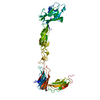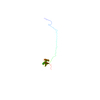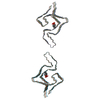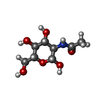Entry Database : PDB / ID : 7s7kTitle Crystal structure of the EphB2 extracellular domain Ephrin type-B receptor 2 Keywords / / / Function / homology Function Domain/homology Component
/ / / / / / / / / / / / / / / / / / / / / / / / / / / / / / / / / / / / / / / / / / / / / / / / / / / / / / / / / / / / / / / / / / / / / / / / / / / / / / / / / / / / / / / / / / / / / / / / / / / / / / / / / / / / / / / / / / / / / / / / / / / / / / / / / / / / / / / / / / / / / / / / / / / Biological species Mus musculus (house mouse)Method / / / Resolution : 3.15 Å Authors Xu, Y. / Xu, K. / Nikolov, D.B. Funding support Organization Grant number Country National Institutes of Health/National Cancer Institute (NIH/NCI)
Journal : Int J Mol Sci / Year : 2021Title : The Ephb2 Receptor Uses Homotypic, Head-to-Tail Interactions within Its Ectodomain as an Autoinhibitory Control Mechanism.Authors : Xu, Y. / Robev, D. / Saha, N. / Wang, B. / Dalva, M.B. / Xu, K. / Himanen, J.P. / Nikolov, D.B. History Deposition Sep 16, 2021 Deposition site / Processing site Revision 1.0 Oct 27, 2021 Provider / Type Revision 1.1 Oct 18, 2023 Group / Refinement descriptionCategory / chem_comp_bond / pdbx_initial_refinement_modelRevision 1.2 Nov 13, 2024 Group / Category / pdbx_modification_feature / Item
Show all Show less
 Open data
Open data Basic information
Basic information Components
Components Keywords
Keywords Function and homology information
Function and homology information
 X-RAY DIFFRACTION /
X-RAY DIFFRACTION /  SYNCHROTRON /
SYNCHROTRON /  MOLECULAR REPLACEMENT / Resolution: 3.15 Å
MOLECULAR REPLACEMENT / Resolution: 3.15 Å  Authors
Authors United States, 1items
United States, 1items  Citation
Citation Journal: Int J Mol Sci / Year: 2021
Journal: Int J Mol Sci / Year: 2021 Structure visualization
Structure visualization Molmil
Molmil Jmol/JSmol
Jmol/JSmol Downloads & links
Downloads & links Download
Download 7s7k.cif.gz
7s7k.cif.gz PDBx/mmCIF format
PDBx/mmCIF format pdb7s7k.ent.gz
pdb7s7k.ent.gz PDB format
PDB format 7s7k.json.gz
7s7k.json.gz PDBx/mmJSON format
PDBx/mmJSON format Other downloads
Other downloads 7s7k_validation.pdf.gz
7s7k_validation.pdf.gz wwPDB validaton report
wwPDB validaton report 7s7k_full_validation.pdf.gz
7s7k_full_validation.pdf.gz 7s7k_validation.xml.gz
7s7k_validation.xml.gz 7s7k_validation.cif.gz
7s7k_validation.cif.gz https://data.pdbj.org/pub/pdb/validation_reports/s7/7s7k
https://data.pdbj.org/pub/pdb/validation_reports/s7/7s7k ftp://data.pdbj.org/pub/pdb/validation_reports/s7/7s7k
ftp://data.pdbj.org/pub/pdb/validation_reports/s7/7s7k
 Links
Links Assembly
Assembly
 Components
Components
 Trichoplusia ni (cabbage looper)
Trichoplusia ni (cabbage looper) X-RAY DIFFRACTION / Number of used crystals: 1
X-RAY DIFFRACTION / Number of used crystals: 1  Sample preparation
Sample preparation SYNCHROTRON / Site:
SYNCHROTRON / Site:  APS
APS  / Beamline: 24-ID-C / Wavelength: 0.9795 Å
/ Beamline: 24-ID-C / Wavelength: 0.9795 Å Processing
Processing MOLECULAR REPLACEMENT
MOLECULAR REPLACEMENT Movie
Movie Controller
Controller








 PDBj
PDBj







